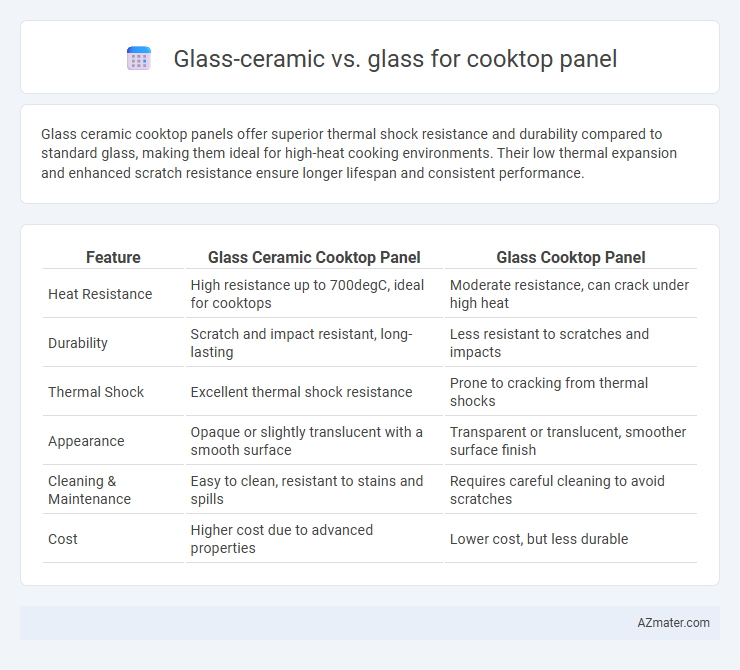Glass ceramic cooktop panels offer superior thermal shock resistance and durability compared to standard glass, making them ideal for high-heat cooking environments. Their low thermal expansion and enhanced scratch resistance ensure longer lifespan and consistent performance.
Table of Comparison
| Feature | Glass Ceramic Cooktop Panel | Glass Cooktop Panel |
|---|---|---|
| Heat Resistance | High resistance up to 700degC, ideal for cooktops | Moderate resistance, can crack under high heat |
| Durability | Scratch and impact resistant, long-lasting | Less resistant to scratches and impacts |
| Thermal Shock | Excellent thermal shock resistance | Prone to cracking from thermal shocks |
| Appearance | Opaque or slightly translucent with a smooth surface | Transparent or translucent, smoother surface finish |
| Cleaning & Maintenance | Easy to clean, resistant to stains and spills | Requires careful cleaning to avoid scratches |
| Cost | Higher cost due to advanced properties | Lower cost, but less durable |
Introduction to Cooktop Panel Materials
Glass ceramic cooktop panels offer superior heat resistance and thermal shock durability compared to traditional glass, making them ideal for high-temperature cooking surfaces. The unique composition of glass ceramics allows for rapid heat transfer while maintaining structural integrity under intense heat cycles. In contrast, regular glass cooktop panels are more prone to cracking and heat damage, limiting their lifespan and performance in modern kitchen appliances.
What is Glass Ceramic?
Glass ceramic is a specially engineered material composed of crystalline and glassy phases, designed to withstand high temperatures and thermal shock without cracking. It offers superior heat resistance and durability compared to regular glass, making it ideal for cooktop panels exposed to rapid temperature changes. Unlike standard glass, glass ceramic provides enhanced mechanical strength and a smooth surface that resists scratches and stains.
What is Conventional Glass?
Conventional glass used in cooktop panels is typically soda-lime glass, known for its affordability and moderate heat resistance but lower durability under rapid temperature changes. Glass ceramic, by contrast, is engineered with crystalline structures allowing it to withstand high thermal stress, making it more suitable for cooktops with direct heating elements. The enhanced thermal shock resistance and strength of glass ceramic panels reduce the risk of cracking compared to conventional glass, which can obscure or degrade under prolonged heat exposure.
Heat Resistance Comparison
Glass ceramic cooktop panels exhibit superior heat resistance compared to traditional glass, withstanding temperatures up to 700degC without cracking or deforming. In contrast, standard glass panels typically endure lower temperatures, around 300-400degC, making glass ceramic more suitable for high-heat cooking environments. This enhanced thermal stability ensures durability and safety during intensive cooking sessions.
Durability and Longevity
Glass ceramic cooktop panels offer superior durability and longevity compared to standard glass due to their enhanced resistance to thermal shock and high temperatures up to 700degC. Glass ceramic features a microcrystalline structure that prevents cracking and warping, extending the lifespan of cooktops even under frequent and intense heat cycles. Standard glass panels are more prone to scratches, cracks, and heat damage, making glass ceramic the preferred choice for long-term durability in kitchen appliances.
Thermal Expansion Differences
Glass ceramic cooktop panels exhibit significantly lower thermal expansion coefficients, typically around 1.0 x 10^-6 /degC, compared to standard glass with values near 9.0 x 10^-6 /degC, allowing glass ceramics to withstand rapid temperature changes without cracking. This minimal thermal expansion in glass ceramic reduces stress and enhances durability under frequent heating cycles, making it ideal for high-temperature cooktop applications. Standard glass, with higher expansion rates, is prone to thermal shock and breakage when exposed to sudden temperature variations, limiting its reliability in cooktop panels.
Aesthetic and Design Options
Glass ceramic cooktop panels offer superior aesthetic appeal with a sleek, smooth finish that resists scratches and heat discoloration, maintaining a pristine look over time. They provide a wider range of design options, including customizable colors and patterns, enabling seamless integration into modern kitchen styles. In contrast, standard glass panels often have limited design flexibility and are more prone to surface damage, which can affect the overall appearance of the cooktop.
Maintenance and Cleaning
Glass ceramic cooktop panels offer superior resistance to scratches and heat, making maintenance easier compared to traditional glass panels that can be more prone to damage and stains. The smooth, non-porous surface of glass ceramic allows for effortless cleaning with simple wiping, whereas regular glass cooktops often require specialized cleaners to prevent streaks and residue buildup. Glass ceramic's durability reduces the frequency of deep cleaning and potential replacement, enhancing long-term usability and aesthetic appeal.
Cost Considerations
Glass ceramic cooktop panels generally cost more than standard glass due to their enhanced heat resistance and durability, making them a long-term investment for high-performance cooking surfaces. Glass panels tend to be less expensive initially but may require more frequent replacement or maintenance, potentially increasing overall costs over time. Choosing glass ceramic can reduce repair expenses and improve energy efficiency, which offsets the higher upfront price.
Which is Better for Your Cooktop?
Glass ceramic cooktop panels offer superior heat resistance and durability compared to regular glass, making them better suited for high-temperature cooking environments. Their ability to withstand rapid temperature changes without cracking ensures long-lasting performance and safety during cooking. Glass panels may be more affordable but lack the thermal shock resistance, making glass ceramic the preferred choice for most modern cooktops.

Infographic: Glass ceramic vs Glass for Cooktop panel
 azmater.com
azmater.com